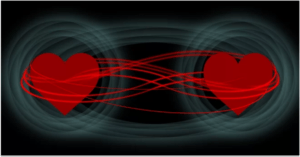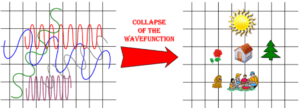In quantum physics, if two particles are entangled, their behavior is correlated. In addition, if a physicist obtains knowledge about the properties of one particle, she has also obtained knowledge about the properties of any particles entangled with it.

Are the daughter particles like a pair of gloves? Here is what I mean. Let’s say that you have a pair of gloves, and you put the left glove in one box and the right in another box. You shuffle the boxes and, at random, keep one of them. You hand the other box to a friend. The friend opens the box and finds a right glove. Your friend is not going to be impressed if you guess correctly that the box that you kept contains a left glove. The properties of the gloves have been “pre-programmed.” Their left-right properties have been correlated in advance.
No, the daughter particles are not pre-programmed. Prior to the measurement of their spins in a detector, their spins were not discoverable nor did their

Prior to one daughter particle being detected, the particles lived in the quantum world, “Quantumland.” Quantumland is a wavy world of possibilities and probabilities. Only upon detection did one of the particles take on physical reality and adopt a particular spin. At the exact moment of detection, because the two particles were entangled, the other daughter particle, across the galaxy, necessarily adopted the opposite spin: counter-clockwise.
In the case of electron spin, entanglement results in the adoption of opposite spin. In the case of light particles (photons), entanglement results in both particles adopting the same polarization. Entanglement doesn’t mean that the entangled particles have identical properties, only that the properties are correlated to a small or a large degree.
Does Entanglement Violate Special Relativity?
Albert Einstein, who developed the Theory of Special Relativity, had a particular problem with quantum entanglement. In 1935, he pointed out in a famous paper called “EPR,” that the mathematics of quantum mechanics implies the possibility of entanglement. The paper also maintained that entanglement could violate Special Relativity.* Special Relativity holds that no object or signal can travel faster than the speed of light. This aspect of Special Relativity is called “locality.” It is the proposition that effects can be caused only by an object or signal touching another, and that touching cannot occur faster than the speed of light.
Yet, according to the mathematics of entanglement, particles half-way across the galaxy from each other can instantaneously correlate their behavior. To say the least, this is a speed faster than that of light. Einstein famously called this “spooky action at a distance.”
Einstein proposed, instead, that “hidden variables” are responsible for the correlation created by entanglement. In the case of the glove example above, the person who arranged for the presence of both a left glove and a right glove would be the hidden variable that created the correlation.
One can imagine factors that we haven’t yet found that pre-determine the opposite spin of the two particles. Part of the hidden variables idea is that the particles have defined properties at all times. For example, in the case of two entangled electrons, each electron would be seen as having a definite spin even before the electrons reveal their spin on a detection screen. In this view, their spin is not adopted at the moment of detection but is always present. This is called “realism.” Realism is the proposition that the existence of a particle is not dependent on observation.
Einstein was a great believer in realism. He is quoted as saying, “I think that a particle must have a separate reality independent of the measurements. That is, an electron has spin, location and so forth even when it is not being measured. I like to think that the moon is there even if I am not looking at it.”
So, the mathematics of entanglement seemed to violate both locality and realism unless hidden variables could be found that would explain correlations of distant particles. At the time that the EPR paper was written, it was not possible to run an experiment that would test whether entanglement actually occurred. The experimental equipment was not sufficiently refined. And it was not possible to test for hidden variables.
In 1964, the physicist, John Bell, published a mathematical paper proposing a way to test for whether hidden variables could account for entanglement. His work is called “Bell’s Theorem” or “Bell’s Inequalities.” In 1972, John Clauser and Stuart Freedman put Bell’s mathematical work to the test. They created an experiment that tested for entanglement and whether hidden variables were at play. Their experiment confirmed the reality of entanglement. They also found that, according to Bell’s mathematics, hidden variables could not explain the correlations in the behavior of entangled particles. The French physicist, Alain Aspect, performed a more definitive test of Bell’s Theorem and was able to confirm the reality of entanglement and reject hidden variables. Physicists have pointed out possible loopholes in the experiments which would allow for locality and realism to hold. However, experiments conducted in recent years increasingly rule out these loopholes.
Entangled Particles Share a Wave Function
In 1935, the Austrian physicist, Erwin Schrodinger, dubbed the strange connection between quantum particles “entanglement.”
“Entanglement, Schrodinger found, is pervasive in quantum physics. When any two subatomic particles collide, they almost always become entangled. When a group of objects forms some larger object, like subatomic particles in an atom or atoms in a molecule, they become entangled. In fact, nearly any interaction between any particles would cause them to become entangled, sharing a single wave function….”**
What does it mean to share a wave function? A quantum particle, prior to being detected, is described mathematically by an equation called a “wave function.” The wave function is derived from the key equation of quantum mechanics, Schrodinger’s Wave Equation. A single wave function describes entangled particles—they share the same wave function. The same mathematical expression describes the behavior of how they both interact.
Footnotes
*The name “EPR” refers to the three authors of the paper: Albert Einstein, Boris Podolsky, and Nathan Rosen. The actual name of the paper is, “Can Quantum-Mechanical Description of Physical Reality Be Considered Complete?” It was published May 15, 1935 in Physical Review. It is one of the most frequently cited papers in quantum mechanics.
**Adam Becker, What Is Real?; Basic Books, 2018; p. 58.
